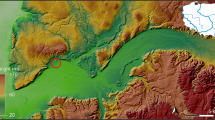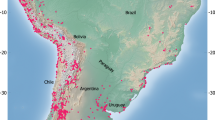Abstract
The purpose of this paper is to discuss recent methodological advances in Argentinean archaeobotany that incorporate the use of ethnobotany as an ethnoarchaeological tool for interpreting ancient food systems in South America. This is an integrative paper that takes into account both published and unpublished results. The role of ethnobotany is examined with reference to ethnobotanical and experimental food processing studies on Prosopis, a wild food plant, and two cultivated ones Chenopodium quinoa and Cucurbita spp., followed by laboratory examinations with microscopy to identify diagnostic changes in plant morphology and anatomy. Experimental materials are then compared with archaeological specimens to identify different types of ancient food processing, and to make inferences about prehistoric post-harvest systems. We demonstrated that: (a) it was critical for our food processing studies to achieve the best taxonomical identification resolution that the plant remains allow; (b) a multi-proxy approach was highly advantageous; (c) ethnobotanical data were crucial to identify food processing pathways of individual plants and combinations of them; (d) the understanding of commensality in the wider sense of the term allows us to determine food patterns both in domestic and funerary contexts. These investigations, the first ones of this type in Argentina, constitute a qualitative step in the methodology for this country because they expand our abilities to interpret the nature of routine plant processing from archaeobotanical assemblages, and they are also a substantial contribution to the development of our discipline in general because the taxa discussed in this paper are distributed throughout South America, as well as in other parts of the world.



Similar content being viewed by others
References
Abraham de Vázquez EM, Garleff K, Liebricht H et al. (2000) Geomorphology and palaeoecology of the Arid diagonal in southern South America. In: Miller H, Hervé F (eds) Geoscientific cooperation with Latin America. Zeitsch Angew Geol SH1, Hannover, pp 55–61
Alcorn J (1995) The scope and aims of ethnobotany in a developing world. In: Schultes R, Von Reis S (eds) Ethnobotany: evolution of a discipline. Dioscorides Press, Oregon, pp 23–39
Allen C (2002) The hold life has: coca and cultural identity in an Andean community. Smithsonian Books, Washington
Babot MP (2009) La cocina, el taller y el ritual: explorando las trayectorias del procesamiento vegetal en el noroeste argentino. Darwiniana 47:7–30
Bruno MC (2008) Waranq waranqa: ethnobotanical perspectives on agricultural intensification in the Lake Titicaca Basin (Taraco Peninsula, Bolivia). Unpubl. Doctoral Dissertation, Missouri, USA
Capparelli A (2011) Elucidating post-harvest practices involved in the processing of algarrobo (Prosopis spp.) for food at El Shincal Inka site (Northwest Argentina): an experimental approach based on charred remains. Archaeol Anthropol Sci 3:93–112
Capparelli A, Lema V (2011) Recognition of post-harvest processing of algarrobo (Prosopis spp.) as food from two sites of Northwestern Argentina: an ethnobotanical and experimental approach for desiccated macroremains. Archaeol Anthropol Sci 3:71–92
Capparelli A, Prates L (2010) Identificación específica de frutos de algarrobo (Prosopis spp., Fabaceae) y mistol (Ziziphus mistol Grises., Rhamnaceae) en un sitio arqueológico de Patagonia. In: Pochettino ML, Ladio A, Arenas P (eds) Traditions and transformations in ethnobotany (ICEB 2009). CYTED, San Salvador de Jujuy, pp 13–19
Capparelli A, Prates L (2015) Explotación de frutos de algarrobo (Prosopis sp.) por grupos cazadores recolectores del sur de Sudamérica: el caso de Patagonia. Chungara
Capparelli A, Lema V, Giovannetti M, Rodolfo R (2005) The introduction of Old World crops (wheat, barley and peach) in Andean Argentina during the 16th century A.D.: archaeobotanical and ethnohistorical evidence. Veget Hist Archaeobot 14:472–484
Capparelli A, Valamoti SM, Wollstonecroft M (2011) After the harvest: investigating the role of food processing in past human societies. Archaeol Anthropol Sci 3:1–5
Ciampagna ML (2012) Prácticas poscolecta -molienda- de grupos cazadores recolectores de la costa norte de Santa Cruz (Holoceno tardío). IX Jornadas de Jóvenes Investigadores en Ciencias Antropológicas, Abstracts, Buenos Aires, p 68
Ciampagna ML, Capparelli A (2012) Historia del uso de las plantas por parte de las poblaciones que habitaron la Patagonia Continental argentina. Cazadores recolectores del Cono Sur Revista de Arqueología 6:45–75
David N, Kramer C (2001) Ethnoarchaeology in action. Cambridge University Press, Cambridge
Giovannetti MA, Lema VS, Bartoli CG, Capparelli A (2008) Starch grain characterization of Prosopis chilensis (Mol.) Stuntz and P. flexuosa DC, and the analysis of their archaeological remains in Andean South America. J Archaeol Sci 35:2,973–2,985
Goody J (1982) Cooking, cuisine and class: a study in comparative sociology. Cambridge University Press, Cambridge
Kuznar LA (2001) Ethnoarchaeology of Andean South America: contributions to archaeological method and theory. (Ethnoarchaeological Series 4) International Monographs in Prehistory, Ann Arbor, MI
Lagiglia HA (1956) La presencia de patay en una tumba indígena de San Rafael (Mza.). (Notas del Museo nº 1) Museo de Historia Natural de San Rafael, San Rafael, Mendoza, Argentina
Lema VS (2011) The possible influence of post-harvest objectives on Cucurbita maxima ssp. maxima and ssp. andreana evolution under cultivation at the Argentinean Northwest: an archaeological example. Archaeol Anthropol Sci 3:113–139
Lema VS, Capparelli A, Martínez A (2012a) Las vías del algarrobo: antiguas preparaciones culinarias en el noroeste argentino. In: Babot MP, Marschoff M, Pazzarelli F (eds) Las manos en la masa: Arqueologías y antropologías de la alimentación en Suramérica, UNC-UNT. Museo de Antropología de Córdoba, Córdoba, pp 639–665
Lema VS, Della Negra C, Bernal V (2012b) Explotación de recursos vegetales silvestres y domesticados en Neuquén: implicancias del hallazgo de restos de maíz y algarrobo en artefactos de molienda del Holoceno tardío. Magallania 40:229–247
Llano C, Andreoni D (2012) Caracterización espacial y temporal en el uso de los recursos vegetales entre los grupos cazadores-recolectores del sur mendocino durante el holoceno. In: Neme GF, Gil A (eds) Paleoecología humana en el sur de Mendoza: perspectivas arqueológicas. Sociedad Argentina de Antropología, Buenos Aires, pp 57–84
Llano C, Ugan A, Guerci A, Otaola C (2012) Arqueología experimental y valoración nutricional del fruto de algarrobo (Prosopis flexuosa): inferencias sobre la presencia de macrorrestos en sitios arqueológicos. Intersecciones en Antropología 13:513–524
López ML, Capparelli A, Nielsen A (2011) Traditional post-harvest processing to make quinoa grains (Chenopodium quinoa var. quinoa) apt for consumption in Northern Lipez (Potosí, Bolivia): ethnoarchaeological and archaeobotanical analyses. Archaeol Anthropol Sci 3:49–70
López ML, Capparelli A, Nielsen A (2012) Procesamiento pre-consumo de granos de quínoa (Chenopodium quinoa– Chenopodiaceae) en momentos prehispánicos tardíos en el Norte de Lípez (Potosí, Bolivia). Darwiniana 50:187–206
Medeiros MFT (2010) Historical ethnobotany: an approach through historical documents and their implications nowadays. In: Albuquerque UP, Hanazaki N (eds) Recent developments and case studies in Ethnobotany. Sociedad Brasileira de Etnobiologia e Etnoecologia. Núcleo de Publicaçóes en Ecología e Ethnobotánica Aplicada, Recife, Brazil pp 127–142
Pollock S (2012) Towards an archaeology of commensal spaces: an introduction. J Anc Stud 2:1–20
Ratto N, Lema VS, Lopez ML (2014) Entierros y ofrendas: Prácticas mortuorias, agrícolas y culinarias en los siglos XIII y XIV en Tinogasta (Catamarca, Argentina). Darwiniana, nueva serie 2:125–143
Samuel D (1996) Approaches to the archaeology of food. Petits Propos Culin 54:12–21
Sherratt AG (1991) Palaeoethnobotany: from crops to cuisine. In: Queiroga F, Dinis AP (eds) Paleoecologia e Arqueologia II. Centro de Estudos Arqueologicos Famalicences, Vila Nova de Famalicão, pp 221–236
Twiss KC (2007) Home is where the hearth is: food and identity in the Neolithic Levant. In: Twiss KC (ed) The archaeology of food and identity, Chapter 3. (Occasional Paper N° 34) Center for Archaeological Investigations, Southern Illinois University Carbondale, pp 50–68
Twiss KC (2012) The complexity of home cooking: public feasts and private meals inside the Catalhöyük house. J Anc Stud 2:53–73
Valamoti SM (2011) Ground cereal food preparations from Greece: the prehistory and modern survival of traditional Mediterranean “fast food”. Archaeol Anthropol Sci 3:19–39
Van der Veen M (2003) When is food a luxury? World Archaeol 34:405–427
Van der Veen M (2007) Food as an instrument of social change: feasting in Iron Age and early Roman southern Britain. In: Twiss KC (ed) The archaeology of food and identity. Center for Archaeological Investigations, Southern Illinois University, Carbondale, pp 112–129
Van der Veen M, Morales J, Cox A (2010) Identifying foodways - new methodological approaches. Terra Nostra 2010/2, Brune-Mettcker, Wilhelmshaven, pp 91
Wollstonecroft M (2007) Post-harvest intensification in late Pleistocene Southwest Asia: plant food processing as a critical variable in Epipalaeolithic subsistence and subsistence change. Doctoral Dissertation, UCL Institute of Archaeology, London
Wollstonecroft M (2011) Investigating the role of food processing in human evolution: a niche constriction approach. Archaeol Anthropol Sci 3:141–150
Wollstonecroft M, Ellis PR, Hillman GC, Fuller DQ (2008) Advancements in plant food processing in the Near Eastern Epipalaeolithic and implications for improved edibility and nutrient bioaccessibility: an experimental assessment of sea club-rush (Bolboschoenus maritimus (L.) Palla). Veget Hist Archaeobot 17(suppl 1):S19–S27
Acknowledgments
The authors are indebted to the Consejo Nacional de Investigaciones Científicas y Tecnológicas (CONICET) PIP 0459 funding to Aylen Capparelli, and to Facultad Ciencias Naturales y Museo, UNLP, which has provided institutional and financial support for this work. The authors would like to thank Michèle Wollstonecroft, who gave us very interesting comments that helped to improve the first version of the text, to the anonymous referees for their invaluable suggestions and to the editors and J. Greig for helping us to improve the English writing.
Author information
Authors and Affiliations
Corresponding author
Additional information
Communicated by S. M. Valamoti.
Rights and permissions
About this article
Cite this article
Capparelli, A., Pochettino, M.L., Lema, V. et al. The contribution of ethnobotany and experimental archaeology to interpretation of ancient food processing: methodological proposals based on the discussion of several case studies on Prosopis spp., Chenopodium spp. and Cucurbita spp. from Argentina. Veget Hist Archaeobot 24, 151–163 (2015). https://doi.org/10.1007/s00334-014-0497-4
Received:
Accepted:
Published:
Issue Date:
DOI: https://doi.org/10.1007/s00334-014-0497-4




